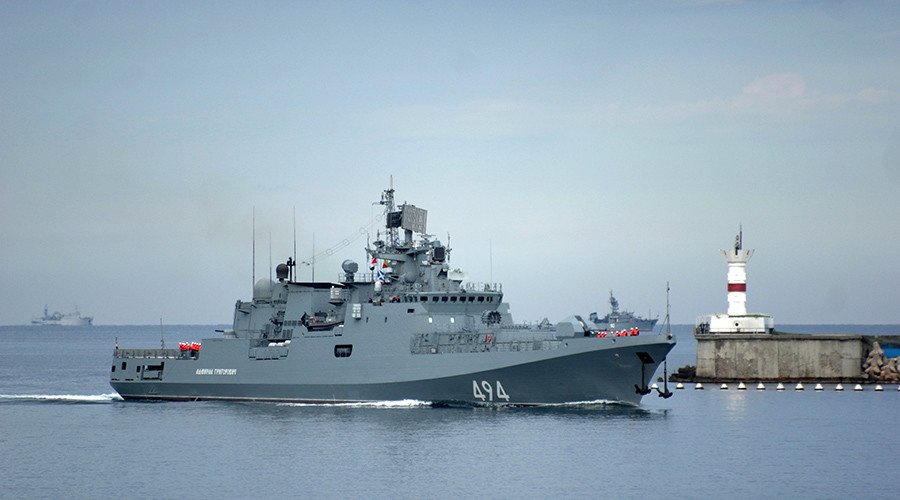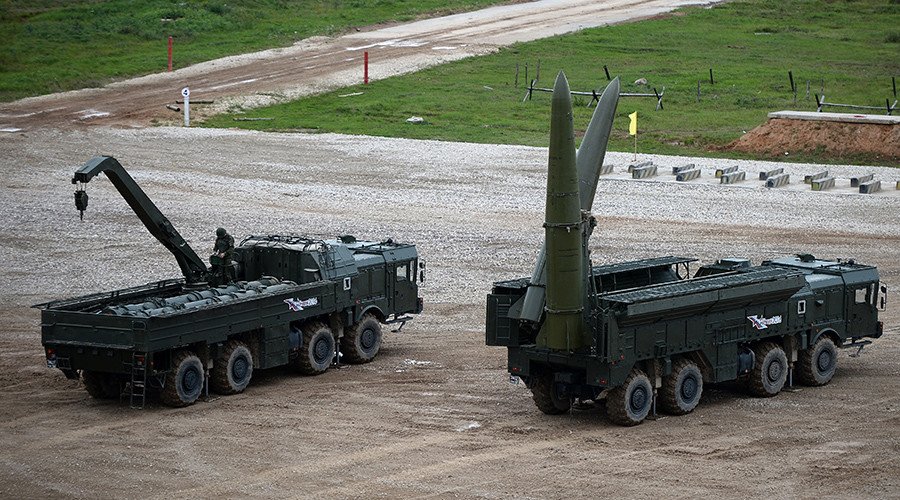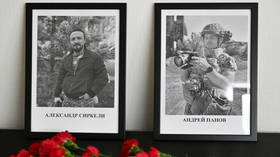Russian Army’s wish list: 100 Armata tanks, Terminators, mystery nuclear-related device (PHOTOS)

The Russian Ministry of Defense revealed its immediate and future plans for hardware procurement. The wish list, including conventional arms, and those “based on new principles of physics” was announced at a major military expo held near Moscow.
Deputy Defense Minister Yury Borisov said that during the Army 2017 expo, the ministry signed 23 contracts worth around 170 billion rubles (over $2.8 billion) with defense producers, many of them for weapons tested during the Syrian campaign.
T-14 Armata main battle tank
The Armata platform, which is considered the future of Russian armor, remains a “trump card” for the defense ministry, Borsov said. “We can play it anytime we want, boost the series production when needed and stay ahead of our colleagues, so to speak,” he claimed.

The current plan is to have 100 Armata-based T-14 main battle tanks in the Russian armed forces by 2020. One of the tank’s main advantages is its fully automated and unmanned turret, as well as HD cameras that provide an outside view. In the future, the tank may be equipped with a drone.
T-90M main battle tank
Yet, the modernized versions of the modern Russian main battle tanks are on par with the competition, so the defense ministry will not rush the replacement of the current fleet with the T-14, Borisov said. The contract signed with Uralvagonzavod, Russia’s primary armor producer, is focused on upgrading older tanks. For the first time, the Russian military will receive T-90M tanks, the third major upgrade of the model, which now has a new turret with a longer 125mm gun and a new fire control system.
Новейшие танки Т-90М «Прорыв-3» поступят в войскаhttps://t.co/tbmMJNZnS9pic.twitter.com/mb79as8EqO
— TOPWAR (@topwar_ru) August 24, 2017
BMPT Terminator anti-tank vehicle
The ministry has also ordered a batch of BMPT Terminators, based on the T-72 tank chassis and is designed to support tank units by targeting enemy anti-tank weapons. Russia’s military purchased some Terminators for test purposes, but the new contract will result in them being put into regular service.

Upgraded BMP-3 armored fighting vehicle
Another novel armor the ministry wants is the BMP-3 infantry fighting machine with the new Epokha turret. The remotely-controlled Epokha was designed as a modular platform that can be outfitted easily with new weapons. The version shown by the producer KBP at the Army 2017 expo had a 57mm autocannon, Kornet anti-tank missile launchers, and Bulat guided missile system, which is currently in development.
Боевой модуль «Эпоха» с новым комплексом вооруженияhttps://t.co/GNN8vcfwYLpic.twitter.com/aJIir2SE9g
— TOPWAR (@topwar_ru) August 25, 2017
Cutting-edge 5th-generation Su-57 fighter jet
Another advanced weapon, the fifth-generation air superiority fighter Su-57, is set to enter service next year. The state-of-the-art aircraft would have an older engine dubbed ‘product 117,’ but work on the new one dubbed ‘product 30’ is “close to the finish line,” the official said. The jet features a body primarily built of composite materials for stealth and supermaneuverability during dog fights.

Yak-152 trainer jet
Far less imposing than the Su-57, but no less important for the strength of the air force, is the training plane Yak-152. The defense ministry expects to sign the first contract for three series Yak-152s before year’s end. The model is designed for military pilots making their first career steps before switching to a more powerful Yak-130, which can also be used as a light fighter. The new plane made its maiden flight last year and will gradually replace the outdated Yak-52 model.

Karakurt-class littoral combat ship
For the Navy, the ministry ordered several more Karakurt-class corvettes, although Borisov refrained from disclosing the amount. The lead ship of the class, the Uragan, was commissioned earlier this year and five more are currently under construction.

The 800-ton ships are meant for littoral zone combat and carry eight Oniks or Kalibr missiles as their main weapon.
Admiral Grigorovich-class blue water frigate
The ministry is also considering new orders for two Admiral Grigorovich-class frigates in addition to the three currently under construction for the Black Sea fleet and the three already complete, the official said. Another possible purchase is two more advanced Lada-class stealth attack submarines. Funding for both has been requested for the new military procurement program launching next year.

A more distant prospect for the ministry is to fund the construction of a new aircraft carrier, which, according to Borisov, may happen as soon as 2025. The future ship will have a new naval fighter jet designed for its deck and possibly another one capable of vertical lift-off, the official said.
Iskander-M cruise missile
The missile producer OKB Novator signed a contract to produce more cruise missiles for the Iskander-M system. The tactical launcher can fire either ballistic or cruise missiles. The ministry also ordered launchers, radar, and control points to arm two more Iskander-M brigades for the Russian ground forces.

Another purchase announced by the Russian military is of the Lotos-M reconnaissance satellite, which “will join a constellation working in the interest of the armed forces” and “provide information support for the Navy,” he said. The spacecraft may be a new version of the Lotos-S signal intelligence satellite. The Russian military has two of them in orbit now and uses them as part of the Liana system, used by the Russian Navy to detect and target potentially hostile targets.
High-speed attack helicopter
The deputy minister also mentioned two R&D projects for the Russian military. One, called Skorost (Russian for ‘speed’), will be conducted over two years by helicopter producer Mil “to create technology basis for developing an aircraft of a new type.” Earlier reports said Mil was working on a Mi-24 version dubbed PSV, which will be capable of attaining speeds of up to 500kmh.

Another, the Zadira-16 (Russian for ‘cocky’) was signed with the Russian Federal Nuclear Center, a Sarov-based nuclear lab with historic ties to Russia’s nuclear weapons program. The system would be “based on new principles of physics,” a term used in the Russian military for non-traditional weapons systems, from direct energy weapons to anything more exotic.













